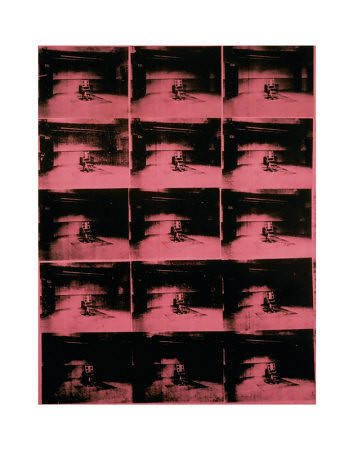My office mates, shell shocked by their own experiences with death sentences and executed clients from Houston, were aghast that I would want to spend my time in "that awful city" but we had heard that there were amazing, world class museums there, something that, despite its amazing culture, cannot be said of New Orleans.
We spent the bulk of our time at the Menil Collection, a stunning modern art campus including the museum, the Rothko Chapel, and the Cy Twombly Gallery.
I lost myself in the collection but was again brought back to my work and the death penalty by a large, pink silkscreen in the museum, Andy Warhol's "Lavender Disaster".
 Fifteen electric chairs in rows on three in lavender.
Fifteen electric chairs in rows on three in lavender.I have no sense at all of what Warhol would have been thinking in slathering this grim device in the color of little girls, repeating it over and over, and then hanging it in a gallery, but for me it drove home the ubiquity of the death penalty in American culture.
The electric chair, despite its exclusively violent application and its hint of the previous crimes of the men and women who would sit in it, is as iconographically American as Campbell's Soup.
Whether you are in Houston, Texas or New York City, the death penalty is part of what defines us as a people. We are inheritors of a Western cultural tradition in which the executions of Socrates and Christ are two of the most culturally significant milestones.
Looking at "Lavender Disaster", I made note of all of the art and culture that I could remember that meditated on the death penalty. The art and poetry opposing the executions of Sacco and Vanzetti and the Rosenbergs. Capote's In Cold Blood. Plato's Phaedo. Camus' The Stranger. Villon's Epitaph. Dostoevsky's ruminations about condemned men in The Idiot. Miro's triptych. The list went on and on.
I resolved to put all of these things together in one place and create a cultural catalog of the death penalty that could focus and inform the discussion on the death penalty in modern America by looking at the ways in which it has been harnessed culturally over the past 30o0 years. I've been working on it, in fits and starts, since then.
*** I have a long working list that I have compiled with Jill McDonough of poetry, paintings, films, literature, and music the dwell on capital punishment, some of which I will continue to post here. I welcome any suggestions.

No comments:
Post a Comment